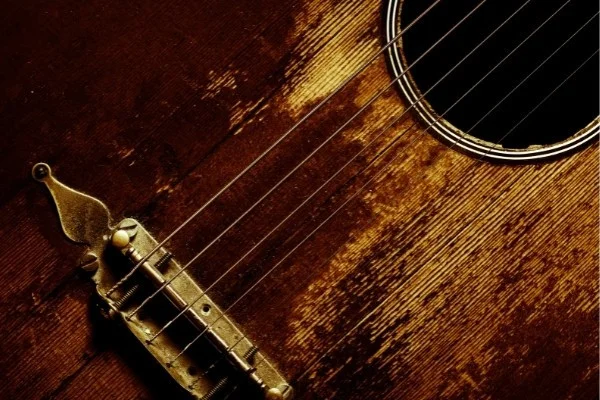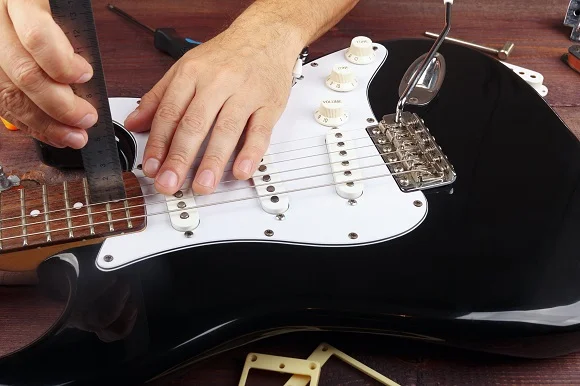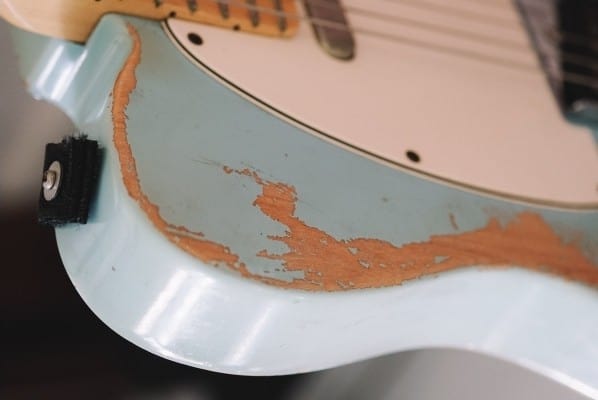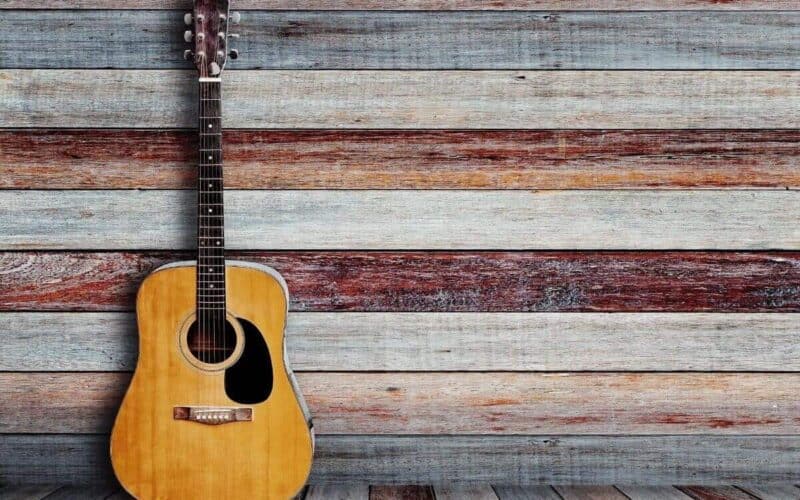You might want to buy an acoustic guitar, but you’re short on cash. You’re therefore left with one option, to purchase a second-hand acoustic guitar. One thing to know is that the quality of a second-hand guitar will not be on par with a new one, but it can be almost as good if the right factors are considered.
Before going to grab a used guitar instead of a new one, you should know what to look for when buying a used acoustic guitar.
10 Things to Look for When Buying a Second Hand Acoustic Guitar
If you don’t know what to look for in a second-hand guitar, worry not. We’ve got you covered. Our article looks at what to look for when buying the best-used guitars. Here are the guidelines to follow when buying a used guitar:
1. Age and Condition of the Guitar
The first thing to check out is the age and condition of the guitar. Check for any physical damage to the body of the guitar. Inquire whether the guitar has had any repairs of late.
If there are any, ask the seller how it happened. The seller should be honest with you and reveal any maintenance or problems the acoustic guitar has had of late. You would be aware of any problems likely to be faced in advance if you know about previous repair and maintenance history.

We all fall in love with what we see. The appearance of the guitar will tell if it has been taken good care of. Ensure that the guitar is in good shape.
Since it is used, it will probably show some little signs of wear and tear or small scratches and scrapes. The performance should, however, be relatively good. A used guitar that is well cared for is easily noticeable.
2. Play it and Check the Sound
This is the most important part of the whole process. You have to play the acoustic guitar and check out the sound. Bend the strings and listen to the spectrum of sounds produced.
Try out and pay attention to all the frets and not just the ones you are playing, especially the ones at the hole end of the fret. Disregard these strings as they’re probably older than you. Listen for the rattling and ringing of the strings.
The advantage of playing the guitar is that it gives you a clue about the performance of the guitar. The fact that it is a used acoustic guitar doesn’t mean that its performance should be compromised.
Here are some aspects you should be on the lookout for:
Tone: The tone of an acoustic guitar is affected by many factors like age, type of wood used, string quality, and so forth. When testing the tone, you should be on the lookout for a guitar that has a rich and full sound. The tone should be even across all the strings.
Volume: The volume of an acoustic guitar has influenced by many factors. When testing the volume, you should ensure that the guitar can be heard even when played softly. It should also have enough power when played loudly.
Sustain: The sustain of an acoustic guitar affects by the body construction, the type of wood used, and the string quality. When testing for sustain, you should play a note and hold it for as long as possible. The longer the sustain, the better.
Finally, give the strings a good tune-up. New strings will make any guitar sound better, but it’s especially important on a used guitar. Out-of-tune strings can make even the best guitar sound bad.
3. Check the Action

The action of the guitar is the distance between the strings and the fretboard, from the head down to the bridge. High actions make the guitar more difficult to play. The vice versa is also true. Lower actions are very easy on the hands and don’t sound very meaty but if it’s too low, the strings may buzz when you play.
Though guitar action depends on the player’s taste and playing style, the action should be as low as you can play separate notes at the 12th fret without any buzz. The stable action height is around 2.8mm on the low E string (bass side) and 2.0mm on the high E string (treble side) for acoustic.
Good action comes with consistency in the gap between the strings and the fretboard. Music stores offer services for adjusting the guitar’s action.
4. Guitar Neck Test
The neck is the most important part of the guitar that supports the strings and maintains the tension for playing the sounds in tune. Also, the playability of the instrument depends on the guitar’s neck.
First, visually inspect it. It should be vertically straight, although some normally come when a little bowed. The neck joint attaching the body of the guitar ought to be flush.
Another critical thing to look for when buying a pre-owned acoustic guitar is whether or not it will need a neck reset. It is a big job and can be relatively expensive, so it’s something you’ll want to avoid if at all possible. When checking the neck, you should:
Check for cracks: Cracks in the neck can seriously affect the sound and playability of an acoustic guitar. If you see any cracks in the neck, even for a small one, it is best to avoid that guitar.

Check for warping: Warping can also affect the sound and playability of an acoustic guitar. To check for neck warping, you’ll want to grab your guitar and look down the neck from the top of the peghead or from the guitar bridge up to the headstock.
With good lighting, you should be able to tell if the neck is warped by looking for a winding and twisting staircase pattern. If you see this pattern, it’s likely that the neck is warped and not suitable for playing.
Check the neck joint: The neck joint is liable for the strength and steadiness of the neck. To check the joint, hold the guitar neck in one hand and try to move it back and forth. If you notice any movement and the joint seems loose, you should avoid that guitar.
5. Check Bridge and Saddle
The bridge is one of the vital sections of the guitar, and it’s also one of the most vulnerable. A tell-tale sign of trouble is a gap between the bridge and the top wood of the guitar body. It is a symptom that the bridge is starting to get detached from the body.

Another sign of a problem is if the areas around the bridge are visibly sunken or bulging. It can happen when a guitar’s action remains too high for a very long duration. If you see this or an improperly set bridge, it’s best to walk away from the guitar.
You should check the saddle carefully since it’s another crucial part of the guitar. There should be some room for the saddle to be downcasted. It’s an alarming sign if the large portion of the saddle has already filed down. The saddle shouldn’t have big grooves, as this is another indication that a neck reset is required.
6. Check the Truss Rod
The neck is one of the most significant parts of the guitar, so you’ll want to make sure it’s in good shape. Checking the truss rod is a good way to do this.
Reinforced necks are okay, but truss rods are even better. They provide extra support and stability to the neck, helping to prevent warping and other damage.
A neck reset is also crucial to consider if the used guitar you’re looking at has an adjustable truss rod. It will allow you to make adjustments to the neck if necessary, ensuring that it remains in good condition.
7. The Comfort of the Guitar
Guitars come in different shapes and sizes and also vary in neck widths and depths. A good guitar gives you the privilege of holding it properly in that each hand and arm can perform the required movement comfortably and correctly. The guitar should ‘fit’ you.
When testing it out, look for signs of finger strains and hand fatigue. Guitars that come with very wide fretboards will be too wide for your hand. This will lead to extra stretching leading to tendonitis. It goes without saying that comfort is essential.
8. Dings and Cracks

Ensure that you check for any cracks, chips, and scratches that come off the guitar. Since the guitar is second-hand, there is no problem if it comes with little cracks.
The problem lies in deep cracks that go down the wood through the finish. Such a crack is a sign of separating seams. Avoid such guitars at all costs. It can be very expensive to fix a guitar with structural damage.
9. Rust
Another thing to look out for in your guitar is rust. Check if there are any rusts, not necessarily on the fret bars and strings, but mostly on the hardware holding the pickups and strings.
Rusts on the stings and frets are easily remedied, but this isn’t the case with those on the hardware. If such rust is present, you should reconsider buying the acoustic guitar.
10. Physically Test the Guitar
Back in the day, you would only find guitars in music stores or flea markets or from people searching for quick cash.
Nowadays, there are online sites coming with the option of buying a used guitar online. Such sites include Amazon, eBay, and Craiglist. Whereas from the music stores you can test them out, this isn’t the case with online buying sites.
If it is possible, you should avail yourself of the store and test the guitar out yourself. This will give you a good knowledge of what you are looking for and settling for.
Should you buy a used guitar?
There are several reasons why you should buy a used acoustic guitar. Here I’m going to look at some of the main reasons.
1. Older guitars are generally a lot cheaper than their new counterparts
As mentioned above, pre-owned guitars are often 50% less expensive than new models. There are several factors involved in price reduction, like the guitar’s age, the guitar’s overall condition, and whether it is refurbished or not.
Older used guitars (age >10 years) may have been played more gently or forgotten about playing. For newer used guitars (age <5 years), it could be trade-ins or factory seconds fixed up by a reputable dealer.
Additionally, second-hand guitars generally don’t have the same warranty or guarantee as a new guitar, and it can make them more affordable. No matter what, though, you’re likely to save a significant amount of money by opting for a used gear instead of a new one.
Also Read: If you are interested to look into new acoustic guitar then check our article on good acoustic guitar costs.
2. Aged wood and matured sound
The wood on a used guitar has had time to settle and mature, giving the instrument a richer sound. It is because the wood has had time to cure, which makes it more resistant to changes in humidity and temperature.
Also, the wood may have been affected by anaerobic bacteria, which can add to the depth of the sound.
3. Used guitars have more personality and history
It is a matter of personal preference, but many people feel that older guitars have more character than new ones. This is because they have been played and loved by their previous owners and often come with a history and stories attached to them.
Further, each used guitar is unique due to the different woods and materials used in its construction.
4. You can find a diamond in the rough
If you’re willing to put in the time and effort, you can find a surprisingly used instrument from famous guitar brands for a fraction of the price of a new one. This is because many people don’t know how to take proper care of their guitars or don’t have the time to do so and end up selling them for far less than they’re worth.
With a little bit of research and patience, you can find an incredible deal on a used vintage guitar that would cost twice as much if it were new.
5. Used guitars are more eco-friendly
It may not be a concern for everyone, but buying a used guitar is more eco-friendly than buying a new one. Since the wood on a used guitar has already been harvested, there is no need to cut down additional trees.
Besides, pre-owned guitars often don’t come with all the packaging and materials that new guitars do, which can further reduce their environmental impact.
Conclusion
There you have it- the factors to consider when purchasing a second-hand acoustic guitar. The fact that we don’t have enough cash doesn’t imply that we can’t enjoy our guitars. Used and second-hand guitars are also good options, but only if you consider the above points.
Ensure you test the strings and look for the physical condition of the guitar. You don’t want to spend even more on the repairs than what you spent buying the guitar. Also, look for reviews on the best second-hand guitars.

